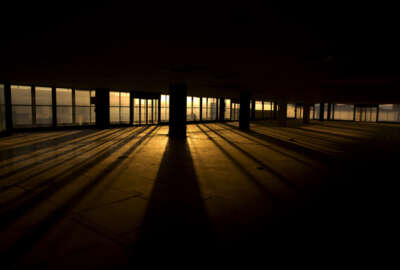
Nearly 1 in 5 DoD facilities now in ‘failing’ condition after years of maintenance cutbacks
Military facilities in "failing" condition increased from 7 percent last year to 19 percent this year.
The number of facilities that are so poorly maintained that they now meet the Pentagon’s definition of “failing” has more than doubled in just the past year, a result of conscious decisions to make building upkeep a low priority during a period of constrained budgets.
At this time last year, the Pentagon reported that 7 percent of its facilities were in failing condition. As of this week, the figure stands at 18.9 percent, a reflection of budget decisions that officials have previously acknowledged would require the acceptance of “significant risk” in facility maintenance in order to preserve scarce operating and maintenance funds for training and to make up for other military readiness shortfalls.
In 2015 and early 2016, more and more buildings that were already in poor condition slipped into the failing category according to DoD’s Facility Condition Index, and things are almost certain to get worse over the next two years. The Pentagon’s 2016 budget asked for only enough facility sustainment, restoration and modernization funds to cover 81 percent of its actual maintenance needs for existing facilities. The 2017 budget request of $7.5 billion would cover just 74 percent of the annual maintenance bill.
“We have over 52,000 buildings in poor or failing condition right now,” said Katherine Hammack, the assistant secretary of the Army for installations, energy and environment. “The majority of our facilities budget is focused on combatant commander requirements and new missions, which for us means cyber and unmanned aircraft. What it doesn’t get after is the significant number of buildings out there that are already failing.”
All three military departments say they prioritized new construction over existing facility sustainment in the 2017 budget, but the separate “MILCON” budget would also be 14 percent lower in 2017 than in 2016, and the lion’s share of that funding would be used to support ongoing military operations overseas. Domestically, the priorities would be for facilities that must be built or upgraded to support new aircraft such as the F-35 – not for existing buildings that have deteriorated so much that they need to be torn down and replaced.
“The MILCON backlog is very significant,” said Miranda Ballentine, the assistant secretary of the Air Force for installations, environment and energy. “We’re only able to afford about about 30 of the 500 top priority projects that our major commands asked us for this year. We really are in a position where it’s not a matter of whether infrastructure is going to fail, it’s a matter of where and when. We have a robust process to prioritize our worst problems first, but without a crystal ball it’s hard to know where that’s going to happen.”
Dennis McGinn, the assistant secretary of the Navy for energy, installations and environment said all the military branches have been putting more effort into gathering and centralizing their data about discrete aspects about their buildings’ conditions in an effort to ensure they’re spending what facility sustainment dollars they have in ways that are likely to head off the most catastrophic problems.
“It’s really important that the roof doesn’t leak, so we need to make sure we’re putting that kind of structural work ahead of repairing or replacing the appliances inside the building,” he said. “We’re working to categorize the most critical aspects of our sustainment mission.”
And for the fifth year in a row, military officials pointed out that the deterioration in DoD buildings has a lot to do with the fact that its limited maintenance dollars are spread across tens of millions more square feet of built real estate than is actually needed. In the 2017 budget, the department again called for a Base Realignment and Closure (BRAC) round in 2019.
The excess capacity problems are most acute in the Air Force and Army. Those services’ rough calculations suggest that they have 30 percent and 21 more facility space, respectively, than they can put to practical use.
Hammack said the Army’s troubles with unneeded facilities will only grow worse as its active duty force continues its drawdown to 450,000 soldiers by the end of next year.
“The drawdown is continuing to create empty space on our bases,” she said. “Our costs to operate a base are about the same whether it’s 75 percent full or 100 percent full. When we can consolidate and optimize our infrastructure we can focus our funding on warfighter needs. The Army has real estate that’s left over from a World War II when we had an active duty force of 8.3 million soldiers, and prior BRAC rounds have only whittled away at that. We’ve never reduced it to the 7 to 10 percent margin where we should probably be operating.”
In the absence of a BRAC authorization, the Army’s installation management command ordered all of its base commanders to consolidate their tenants into their newest and best buildings a few months ago so that older facilities can be mothballed – avoiding the costs of facility upkeep and of demolition until budgets improve.
“You don’t have to pay for lighting, you can turn the temperature controls down and essentially put those facilities into cold storage,” Hammack said. “We’ve identified about 40 million square feet of building space that that we could shut down in that way. It’s going to take some time to relocate our personnel into those newer facilities, but we think it could lead us to about $140 million in annual savings.”
But that’s a far cry from what officials believe could be saved from closing some bases altogether. Even including the up-front costs of the unusually expensive 2005 BRAC round, the five BRACs that have happened since the early 1990s have cut the department’s costs facility costs by $12 billion per year.
Copyright © 2024 Federal News Network. All rights reserved. This website is not intended for users located within the European Economic Area.
Jared Serbu is deputy editor of Federal News Network and reports on the Defense Department’s contracting, legislative, workforce and IT issues.
Follow @jserbuWFED
Related Stories






